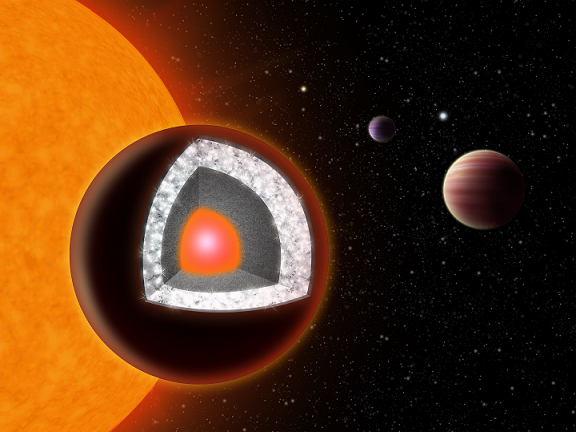Diamonds In Space: 'Super Earth' Has 18-Hour Years, 4000 Degree Temperature

Astronomers say that a planet orbiting a star in the Cancer constellation contains a layer of diamond as massive as three Earths.
The planet in question, the “super-Earth” 55 Cancri e, lies about 40 light-years away from Earth and was originally discovered in 2004. Though twice the width of Earth, scientists have deduced that it is nearly eight times as heavy. 55 Cancri e is also moving at a much faster pace than we are, with a year that lasts just 18 hours. And it’s not exactly a feasible vacation destination, unless you are comfortable with a forecast of about 3,900 degrees Fahrenheit.
In a paper forthcoming in Astrophysical Journal Letters, Yale University researcher Nikku Madhusudhan and his colleagues explain how they used existing knowledge about 55 Cancri e to guess which elements lie at the heart of the mysterious satellite.
“Once you have the mass and radius of the planet, can go about thinking what kind of materials give you those figures,” Madhusudhan said in a phone interview.
The researchers ran through different combinations of elements to figure out that 55 Cancri e is about one-third diamond, by mass.
According to their model, the diamond is mostly in a thick layer just underneath the planet’s surface, which itself is likely a mix of diamond and graphite. Below the diamond layer and another layer of silicon, and below that is a core of molten carbon -- different from the Earth’s core, which is made of molten iron.
55 Cancri e’s unique composition results from its unique chemical makeup. Though some researchers had thought the planet was similar to Earth, Madhusudhan and his colleagues say it’s more likely that the planet is mostly made of carbon -- which yields both diamond and graphite -- plus iron, silicon carbide and possibly silicates.
Madhusudhan says that their finding underscores the fact that researchers cannot immediately assume that extrasolar rocky planets are Earth-like in terms of their chemical constituents and biology.
“With other earth-like planets, we have typically assumed them to have the same sort of chemistry as on Earth,” Madhusudhan said. “If a planet is carbon rich, all of that is going to change.”
Future work on 55 Cancri e will probably be devoted to figuring out what kind of atmosphere it has. Because it’s a carbon-rich planet, Madhusudhan guesses that the most likely components are carbon monoxide and hydrocarbons -- a group of organic compounds that includes methane and propane.
While 55 Cancri e is likely too hot for life, there may be other planets orbiting the same star in a more habitable zone. And if life arose there, breathing carbon monoxide and living with very little water, it would be something entirely different from anything we know.
“We’ve just gotten the first hint,” Madhusudhan says. “Now we have to dig deeper.”
SOURCE: Madhusudhan et al., “A Possible Carbon-Rich Interior In Super-Earth 55 Cancri e.” Astrophysical Journal Letters in press.
© Copyright IBTimes 2025. All rights reserved.





















